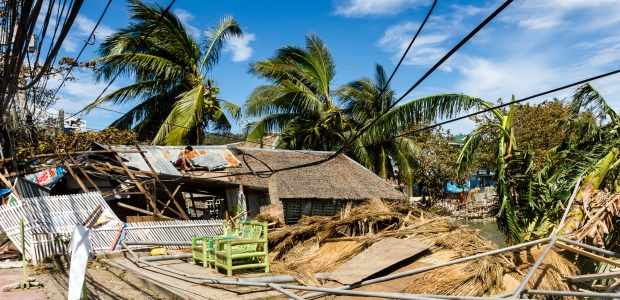
Severe Weather Events and the National Flood Insurance Program
Will federal flood insurance reforms fully embrace the new reality of climate change driving frequent and intense storms?
- By Stuart Souther, Jake Beckstrom
- Dec 23, 2013
Typhoon Haiyan—one of the most powerful “superstorms” in recorded history—caused more than 5,200 deaths and displaced an estimated four million people in the Philippines this fall. Kerry Emanuel, professor of Atmospheric Science at M.I.T., predicts an increase in the intensity and frequency of tropical cyclones as a consequence of climate disruption—the warming of the planet due to the steady increase in greenhouse gases. If this prediction is accurate, more powerful storms will make landfall more frequently in the U.S. over the course of the next several decades and beyond. These storms are likely to play an increasingly prominent role in U.S. politics, policy, and law as debate grows over the issue of who should bear the costs of recovery and restoration. One of the most contentious issues in 2014 may prove to be reform of the National Flood Insurance Program (“NFIP”).
The Biggert-Waters Flood Insurance Reform Act of 2012 (“Biggert-Waters”) provides for the phase-out of federally subsidized flood insurance premiums. An outcry from affected policyholders resulted in the introduction on October 29, 2013, of the “Homeowner Flood Insurance Affordability Act of 2013” (“HFIA”) which, at a minimum, would delay implementation of the subsidy phase-out. Biggert-Waters was passed in the aftermath of Hurricane Katrina. As a consequence of Hurricanes Katrina, Irene, and others, by mid-2012 the NFIP had accrued approximately $18 billion in debt. Biggert-Waters was intended to return the increasingly expensive NFIP to sustainability.
While extending the NFIP through 2017, Biggert-Waters also phases out premium subsidies (except for policies on grandfathered primary residences) and establishes a National Flood Mapping Program to more accurately delineate areas at risk. The phase-out of subsidies for commercial properties, non-primary residences, and properties with repeated or severe flood damage has already begun, with premiums rising a maximum of 25% each year until full risk premium rates are reached. Full risk rates apply immediately to policies on properties not previously insured and on properties purchased by new owners. In some cases, full risk premiums will be six to fifteen times higher than current premiums. Many residents of such properties are already finding the higher premiums unaffordable, yet many such properties can no longer be sold, except at a substantial loss. Further, as flood zone maps are updated, an increasing number of homeowners with mortgages will be surprised to learn that they are in a flood zone and must purchase expensive flood insurance.
Congresswoman Maxine Waters (D-CA), co-sponsor of Biggert-Waters, is also a co-sponsor of the HFIA. The HFIA would delay the phase-out of subsidized premium rates until two years after FEMA completes a study, mandated by Biggert-Waters, of methods of ensuring the affordability of full risk rates—a task that is expected to take two years.
In connection with this study, Biggert-Waters requires FEMA to retain the National Academy of Sciences to conduct a cost-benefit analysis comparing the current, subsidized system to a system in which full risk rates would be combined with means-tested assistance for those who would not otherwise be able to afford coverage. The HFIA also requires FEMA to submit a proposal to Congress for “programmatic and regulatory changes” to the NFIP–intended to address affordability.
As the planet warms and storm-related flooding is more frequent, severe, and widespread, subsidizing insurance for flood zone residents will become a growing drain on the public purse. Addressing that concern while mollifying affected constituents is likely to be an increasingly difficult task for our legislators. Each new “superstorm” is likely to call further attention to this issue, making it increasingly difficult for policymakers to ignore.
About the Authors
Stuart Souther is an Environmental Law LL.M. candidate at Vermont Law School with a focus on climate disruption and energy policy. With two decades of experience as a corporate attorney, he has most recently served as general council of Hoya Corporation, a Japanese public company.
Jake Beckstrom is a staff editor at VJEL and graduated summa cum laude from Southwest Minnesota State University with a degree in environmental science. He strongly believes in science-based conservation to protect our natural heritage for future generations.